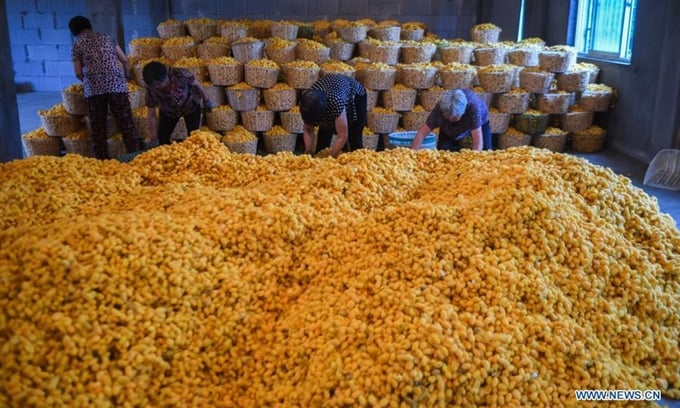November 21, 2025 | 04:47 GMT +7
November 21, 2025 | 04:47 GMT +7
Hotline: 0913.378.918
November 21, 2025 | 04:47 GMT +7
Hotline: 0913.378.918

Staff arrange purchased "golden cocoons" at a sericulture cooperative in Jiansheng Village of Tongxiang City, east China's Zhejiang Province, May 26, 2021. Tongxiang, east China's Zhejiang Province, is famous for its over 4,000 years' history of sericulture. Its silkworm breeding and mulberry planting tradition has been listed by the State Council as the national intangible cultural heritage. A new variety of silkworm called "golden cocoon" is pale gold in color. Photo: Xinhua
The gene pool of silkworm resources at Southwest University in Southwest China's Chongqing Municipality has been confirmed as a national gene pool of the species with the longest history in China, with the most complete types preserved and the most innovative discoveries made.
This is the first time for China to identify a national gene pool of silkworm resources, and this was confirmed by the country's Ministry of Agriculture and Rural Affairs.
As the world's largest gene pool of silkworms set up in the 1930s, it has preserved the complete original records of genealogical data collected since 1940, embodied the efforts of several generations of experts and scholars in this field and recognized by the international peers as the "core institution" in this field.
At present, the gene pool preserves more than 1,150 samples of living silkworm genetic resources, covering more than 90 percent of the known genetic variation of the world's extant silkworms, including local resources, improved and practical resources, mutant gene lines, chromosome disorder lines, oriented cultivation lines, innovation of germplasms of genetic modification and gene editing, imported species and species with the introduction of wild ancestral lineages.
With a continuous and systematic research on all kinds of resources, the gene pool has become a comprehensive gene library of silkworm genetic resources, which supports the development of China's silkworm industry and silkworm science with its extremely valuable genetic resources.
Professor Dai Fangyin, who leads the project as director of the State Key Laboratory of Silkworm Genome Biology at the Southwest University, told the Global Times that silkworms have lots of practical uses such as being used as foods and insect feed.
Their silk can be used not only in fabrics but also in materials with special functions. They can also be used in medical science as well as cosmetics. About one-third of the preservation of silkworms in the gene pool has practical uses, Dai said.
Based on the gene pool, the research group from the Southwest University completed the large-scale analysis of silkworm germplasm resources with the genome of over a thousand silkworms, and digitized the silkworm gene pool for the first time in the world, creating a digital silkworm gene pool and completing the world's first super pan-genome map of silkworms.
The pan-genome map of silkworms is also the world's largest long-reads-based pan-genome of the world's plants and animals. It greatly facilitates the research on the genetic basis of important breeding characters and pushed the research on silkworm germplasm resources to the stage of "molecular design breeding."
According to Dai, the "molecular design breeding" of silkworm is to design, optimize, and modify genes at designated sites to create new varieties more in line with new breeding objectives.
According to Dai, as an important national platform for silkworm research, the gene pool is expected to promote the scientific protection, fine evaluation, germplasm innovation and variety breeding and application of silkworm genetic resources in the future.
(Global Times)

(VAN) In a new study published in Trends in Biotechnology, researchers used a gene-editing technology called CRISPR to increase a fungus's production efficiency and cut its production-related environmental impact by as much as 61%- all without adding any foreign DNA.

(VAN) A top official in Beijing’s Cop delegation says China is committed to clean energy – but US’s absence is a problem.

(VAN) The Bangsamoro region’s inflation rate rose slightly to –1.3 percent in October 2025 from –1.5 percent in September, the Philippine Statistics Authority (PSA-BARMM) reported.

(VAN) FAO-led report says protecting and restoring forests is crucial to boosting climate-resilient agriculture, rural livelihoods and global food and water security.

(VAN) Flagship partnership secures additional GBP 16.9 million to strengthen forest monitoring, transparency and country support to 2030.

(VAN) After a turbulent year for international development, the aid and assistance landscape has shifted, with donors rethinking how, where and why they support sustainable development.

(VAN) A new tool for measuring the economic value of farm animal welfare improvements has been developed, potentially transforming how consumers, retailers and the government evaluate animal welfare policies.